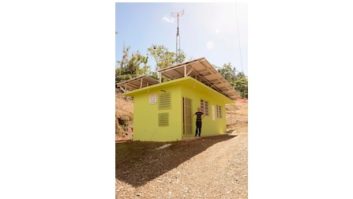The recent price climb of gasoline and diesel fuel serves as a constant reminder that energy costs will remain a significant part of the budget for most broadcasters.
In some cases, fuel costs are changing the way stations operate, causing them to consider alternatives that were once too expensive or unconventional. At the same time, advances in technology are reducing the costs for alternatives such as wind hydro and solar power. We talked to engineers who are going off the grid to meet some of or all of their energy requirements.
In the air

CAPTION
Renewable energy sources such as wind and solar traditionally have been the option of last resort for broadcasters. Mike Bergey, president of Bergey Wind Power Company, notes that in the past, demand has come from customers at remote sites far from the power grid.
“When someone gets an estimate from the electric company that it will cost between a quarter of a million and a million dollars to extend the grid to their site, the capital costs of alternatives like wind or solar become attractive.” He adds that companies that have to fly diesel fuel in to remote sites may also be candidates for alternative energy.
Bergey notes that there are more wind-powered sites in the West, where the penetration of the power grid is less extensive than on the East coast. That may start to change. “The rise in diesel fuel costs is causing more people to look at the alternatives. We’ve been getting a lot more calls and inquiries lately.”
Bergey’s company provided wind turbines and expertise for a hybrid wind/solar installation at KRNG(FM), a Christian station in Wadsworth, Nev. Dr. Bill Bauer, the station program director, said, “Our 8,000-foot mountaintop site was far from the grid. Surveys suggested that a hybrid arrangement would work for us, and the system went on the air in 1997.”
At first, KRNG got too much of a good thing. Sustained 70 mph winds burned out the wind turbine. Adjustments were made, and the system has been reliable ever since. The only maintenance required involves backpacking jugs of distilled water to the site every other month to top off the lead-acid batteries.
KRNG has no backup generator, although diesel or propane-powered units often are used to recharge batteries during periods of overcast skies and low winds when solar panels and wind turbines can’t keep up.
Efficient use of the limited battery power is an important consideration at all off-grid sites. Rather than running the transmitter off an inverter, the battery pack powers the transmitter directly, also providing slightly better hum and noise specifications than AC-powered units.
Batteries at KRNG are deep-cycle lead acid types, although in low-temperature environments where freezing is a possibility or site access is limited, sealed gel-cell batteries are an option. Bergey notes that these types typically cost about 50 percent more than lead-acid cells.
Healthy rays

For stations located in the Sunbelt, solar power may be a logical choice.
Sara Allen of Ciara Enterprises Inc. was chief engineer of KTAO(FM) in Taos, N.M. when it moved to a solar-powered transmitter site. The remoteness of the site ruled out grid power, and preliminary tests suggested that solar would work.
“I didn’t know much about solar at the outset of the project, and most of my education came in the form of on-the-job training,” Allen said. Working with station owner Brad Hockmeyer, Allen installed the radio gear and coordinated the efforts of architect Mike Reynolds, solar specialists Paradise Power, tower riggers and financial backer Guy Spiller of BES Teleproductions.
The system includes 135 solar panels and 60 lead-acid batteries. KTAO has no backup generator at the site, and relies entirely on the sun. While the system was designed to run entirely on batteries for five days, that turned out not to be enough.
“We once had 26 consecutive days of bad weather,” Allen said, “and really had to conserve battery power. If I had it to do over again, I would put in twice as many batteries.”
Allen notes some of the unique features of the system.
“The 600-watt QEI transmitter is a custom job that runs directly off the battery bank, which supplies from 55 to 70 volts depending on the charge state. A voltage regulator in the transmitter provides 48 VDC to the final stage.” KTAO monitors battery voltage from the studio via the remote control. An inverter at the site is only used to provide AC power for lighting.
Although a skeptic at the outset of the project, Allen is enthusiastic about solar energy.
“The track record of KTAO speaks for itself. It’s been on the air for 14 years with no backup. Solar power works.”
Water powerBuying Green Power Installing wind, hydro or solar gear isn’t the only way that broadcasters can benefit from renewable energy sources. They can also purchase energy from green sources.
KRCL(FM), a community station in Salt Lake City, recently signed up to purchase 53 block increments of wind-generated energy from Utah Power’s Blue Sky program. The voluntary program enables Utah Power customers who pay an additional $2.95 per month to purchase wind power in 100-kwh block increments. Another Utah broadcaster, public station KZMU(FM), also participates in the Blue Sky program, deriving 100 percent of its power requirements from the wind.
Similar programs exist in other states. Entercom Radio of Madison recently became the first Wisconsin business customer for Second Nature, a voluntary program that allows Alliant Energy customers in Iowa, Minnesota and Wisconsin to support energy generated from renewable resources. Second Nature contracts with a landfill gas facility, wind farms and solar providers to provide renewable energy.
For other broadcasters, particularly in the Northeast, hydro is a means of going off the grid.
WJFF(FM), Jeffersonville N.Y., is located in the Catskill Mountains, where water-powered turbines provide 70 to 75 percent of the power for the station’s studios. “It gets tough in August, when water levels are low,” said Station Manager Christine Ahern, “then we have to go back on the grid.”
The project began when then-owner Malcom Brown purchased a 21-foot-high dam, knocked a three-foot hole in the side and installed pipes that ducted the water to two turbines; they drive the generators. The entire endeavor cost Brown $100,000 and was preceded by a decade of research on hydroelectric power.
The plant provides ample energy to power Brown’s house and the WJFF studios. He used to sell surplus power back to the utility company, but administrative hassles eventually made that impractical.
The station’s commitment to renewable energy lured the annual Grassroots Radio Conference to Jeffersonville, which WJFF hosted last year. Said Ahern, “Many of the 200 delegates were talking about it, and felt we were an example to encourage them to think about ways of getting off the grid.”
WJFF has additional plans for sustainable energy. “We’ve already got anemometers up at the transmitter site,” Ahern said, “and if conditions are right, we’ll look at powering everything up there with the wind.”
Big power
While WJFF uses hydro on a small scale, powering much larger operations with water is also possible. HCJB World Radio in Quito, Ecuador, has been running its shortwave transmitter site with power from the headwaters of the Amazon since 1965. Charles Jacobson, manager for International Broadcast Technology at HCJB Worldwide, explains: “We were far from the grid, and started out powering the site with surplus diesel generators, which were very expensive to operate. The station obtained a scrap 1.8 MW generator in 1965 and refurbished it for the first hydro site.” He adds that HCJB continued to expand the generating capacity, until today it produces 7.8 MW.
Located in Pifo, 18 miles east of Quito, the transmitter site houses 11 shortwave transmitters, plus one 25 kW MW standby, two 20 kW SSB and two 1 kW SSB transmitters. A 1.2-million-watt power station consisting of four diesel generators is available for backup. The station sells its surplus hydro capacity back to the local power utility to help defray operating costs.
Jacobson adds that most of the hydro and civil engineering expertise for the project has been provided in-house by the HCJB engineering staff. Power from the dams is reliable, with an average of only four hours of down time per month, and many of the outages come from the 30 miles of transmission lines that cross the Andes to connect the hydro plants to the Pifo transmitter site.
“Most of the difficulties come from high winds, but our worst problems came after a volcano erupted nearby, and volcanic ash, which is conductive, settled on the lines and towers. Then it rained.”
While renewable energy sources often save money in the long run, capital and startup costs often are prohibitive. Help is available in some locations. Many states, including Arizona, California, New York, Nevada and Texas, have enacted pioneering laws, and more governors are professing the benefits of renewable energy for their states.
Additional information is available from the Database of State Incentives for Renewable Energy, which has a state-by-state listing of information on state, local, utility and selected federal incentives that promote renewable energy. The Web address is www.dsireusa.org.



